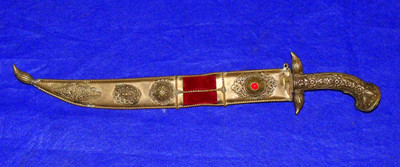On a recent flea market round my place I found this little very interesting folding knife. It is a Turkish grape knife. The blades are held open by friction alone, the handle is plastic with a handmade brass collar. The sickle knife has tiny, well-made serrations, and both blades were razor sharp.
And blimey, they are less than a millimetre thin! That knife cuts like the proverbial devil. It is made in the city of Bursa using a very inetersting mix of traditional techniques and modern technology. Look here for a knifemaking video how they work in Turkey:
There is a lot to learn from Turkish culture. I daresay I am a bit prejudiced what concerns Turkish people in Germany, especially the younger ones. Many of those youth are taking pride in a "gangstah" mentality, are violent and rough, and spill junk and spit wherever they walk. And it is not exactly easy to tell one Muslim from the other, so to say. But if you talk to the elderly people, the ones who can actually still tell you about all that knowledge, which is about to get lost in the process of "europeization" you get a whole different picture. Their hospitality and generosity is simply great, they love to tell stories and are obsessed with good food and good cooking (and don´t confuse "Doner" Kebab with Turkish cuisine, it´s a German invention), and they are diligent workers and craftsmen. I sincerely hope they can preserve those crafts, including knifemaking and blacksmithing.
The next find is also quite interesting. I found one example on www.antiquesnavigator.com like this:

The next photo is mine. It bears some striking similarities to the one above, i.e. the decoration on the guard and pommel, the suede on the sheath, the wirework and the handle décor. The one above sold for 180$. The one below sold for 16€. :-)
The knife is presumeably of Greek or Balkan origin. The blade measures about 24 cm. The handle is cast and silver plated bronze, the sheath mountings seem to be silver plated or nickel silver.
The decoration is finely cast, the soldering accomplished well enough. The suede shows little wear, but is not stitched, but held in place by wirework and a kind of glue which has worn off on some parts.
The decoration is figural which will not allow for a Muslimic country as country of origin, but rather hints towards an orthodox or conventional Christian provenience.
Chape and mouth are bot decorated with beautiful wire work.
The blade is soldered into the handle with a kind of "Habaki" style ricasso out of brass. The blade shows coarse file marks.
The blade, which is out of high carbon steel, is engraved with a stylized fish and a presumeably Greek inscription.
The blade gives a lovely ring when drawn, and seems to be nicely tempered. It is selectively tempered (the spine is softer than the edge). A fine, well hardened and sharp file is just so able to take off shavings, making for an estimated hardness of 58-60 HRC in the edge area.
The blade is very flexible, however, and I guess the temper does not reach deep.
What intrigues me most is that this is most certainly constructed as a cold steel weapon. In central Europe and America, we tend to give daggers and fighting knives hilariously thick spines. Now look at that thickness: It´s just 2,5 mm thick at its thickest and tapers to under a mm. That way this knife will also make for a great slicer and a knife suited for everyday chores as well as mortal combat. But hey, carrying a knife and knowing it´s just to kill people? How sick would that be? Far more realistic is that a knife like this, while suitable for representational and traditional attire duties, was used for butchering, farm work and the like more often than not. It was a valued companion, but also a do-it-all workhorse.
I find it most interesting that all of my tribal knives have spine thicknesses under 3mm, most come in at just 1,5-0,5mm thicknesses. Yap, of course, this is not a prybar. But for prying you can use a prybar. But still, these knives can stand up to a lot of abuse. The secret is in the skill. Modern European and American knives are made by skilled workers, but often mastery is substituted by machinery. If you know your steel and how to work it, you can push it to limits otherwise out of bounds. Plus, if you break your knife in a Balkan village, you go back to the smith who had made it, and he will repair it. In modern capitalism, this is no longer possible, and liability issues are mirrored in the layout of the knife.
It is good to see that the knifemakers in Turkey try to bridge the gap between tradition and modernity.
I, for one have learned a lot by doing the research for this article, and I have gained another different perspective on knifemaking.



















